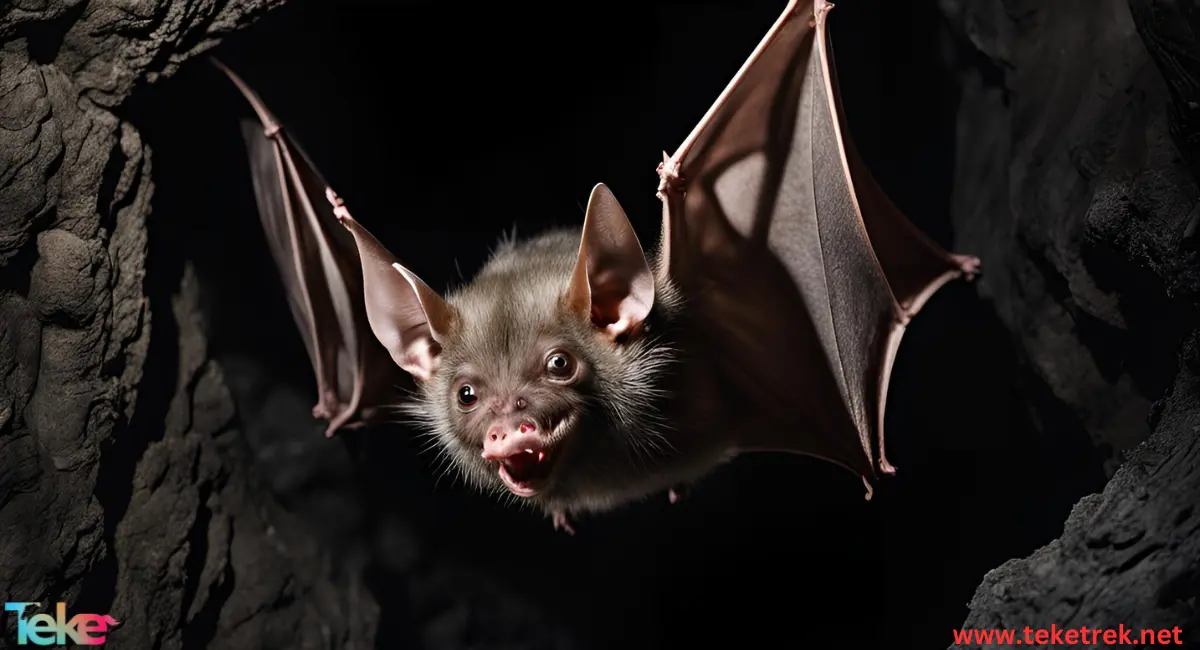From feeding rituals to nocturnal life, vampire bats have been of interest to scientists and researchers for centuries.
The common vampire bat is a small bat with leaf-shaped nose native to Latin America. This is one of 3 existing vampire bats species .
Vampire bats primarily feed on the blood of cattle, often approaching their prey at night while they sleep.
The vampire bat is considered a pest as it feeds on livestock and can transmit rabies.
Let’s learn more about it from teketrek.

General Appearance of Vampire Bats:
The common one has short hair, with silver-grey fur on the underside.
The vampire bat is characterized by defined dark fur on its back.
It has a lower lip with deep grooves.
The vampire bat possesses a flat leaf-shaped nose.
Vampire bats have evolved specialized thumb claws on each wing to climb up to and catch prey.
While most other bats have completely lost the ability to maneuver on the ground, vampire bats are an exception.
Vampire bats can run using a unique gait, where the front limbs are used instead of the hind limbs to propel forward, as their wings are much stronger than their legs.
Habitats of Vampire Bats:
It is found in parts of Mexico, Central America, and South America.
Vampire bats prefer warm and humid climates, utilizing tropical and subtropical forests as well as open grasslands to search for food.
They roost in trees, caves, abandoned buildings, as well as old wells and mines.
Habits and lifestyle of vampire bats:
They live in colonies and cooperate with each other in terms of social care and food sharing.
Colony sizes can range from a few individuals to hundreds at roosting sites.
The basic social structure of vampire bats consists of groups of females and their offspring, along with a few adult males known as “resident males.” Additionally, there’s a separate group of males known as “non-resident males.”
Common vampire bats also coexist with about 45 other bat species and typically dominate their roosting sites.
Vampire bats hunt at night, using echolocation and their sense of smell to track prey.
They feed on blood from animals within 5 to 8 kilometers of their roosts.
When a bat selects a target, it either lands on it or jumps on it from the ground, often targeting the flank, back, or neck of the prey.
Heat-sensing organs in the nose of the vampire bat help it detect blood vessels close to the skin surface.
Vampire bats are capable of piercing an animal’s skin with their teeth, making a small incision, and then lapping up the blood with their tongue (which has grooves adapted for this purpose)
Diet and Nutrition in Vampire Bats:
Common vampire bats are animals carnivorous, primarily feeding on the blood of mammals, especially cattle such as cows and horses. While they can also feed on wild prey like tapirs, they seem to prefer domesticated animals. Among these, they favor horses over cattle when given the choice.
Reproduction in Vampire Bats:
Vampire bats are polygynous, with dominant adult males defending groups of females. They can reproduce throughout the year, though birth rates peak during the rainy season. Females give birth to a single offspring after a gestation period of about 7 months.
The young are primarily cared for by females. Mothers leave their offspring to hunt and call them back to feed upon their return. Offspring accompany their mothers on hunts at around 6 months old but are not fully weaned until around 9 months old. Typically, female offspring of vampire bats remain in their birth groups until adulthood, unless their mothers die or move away.
Male offspring tend to live in their own birth groups until they are around 1 to 2 years old. Sometimes they are forced out by resident adult males. Common vampire bats reach sexual maturity at around 9 to 10 months old.
Population threats to vampire bats:
There are currently no major threats facing common vampire bats.

Frequently Asked Questions about vampire bats:
What is the main food source of vampire bats?
Vampire bats are peculiar creatures belonging to the family Desmodontidae, as their name suggests. They also belong to the order Chiroptera, within the family Phyllostomidae.
Vampire bats primarily feed on blood.
- Do vampire bats feed on human blood?
Contrary to popular belief, it’s rare for vampire bats to feed on human blood.
They do not like direct contact with people and will only bite when their usual prey is scarce.
Primarily, vampire bats target livestock and other mammals like cattle, horses, and pigs. It can eat wild animals including birds and rodents.
- What is the size of a vampire bat?
Vampire bats are small when compared to other bats.
The average wingspan of a vampire bat is about 7 to 8 inches.
Their compact body structures are about 2 to 3 inches long and lightweight, weighing roughly an ounce.
- What are types of vampire bats?
- Common Vampire Bat (Desmodus rotundus): This species is the most widespread and abundant among the three.
- Hairy-legged Vampire Bat (Diphylla ecaudata): It possesses dense fur on its legs, extending to its feet.
- White-winged Vampire Bat (Diaemus youngi): This species is smaller than the others. It inhabits Central and South America and has distinctive white spots on its wings, particularly visible during flight.
- Are vampire bats harmful?
No, it is not very harmful to humans, as it is rare for them to bite.
- How long can vampire bats go without blood?
Vampire bats can live without blood 2 nights.
In short, vampire bats are an exciting and important part of nature’s diversity. They play a vital role in the ecosystem by regulating insect populations and maintaining the balance of nature. Despite their fearsome reputation, vampire bats pose little threat to humans and provide opportunities for exciting studies on the creatures’ adaptations to their environment. Sources:





